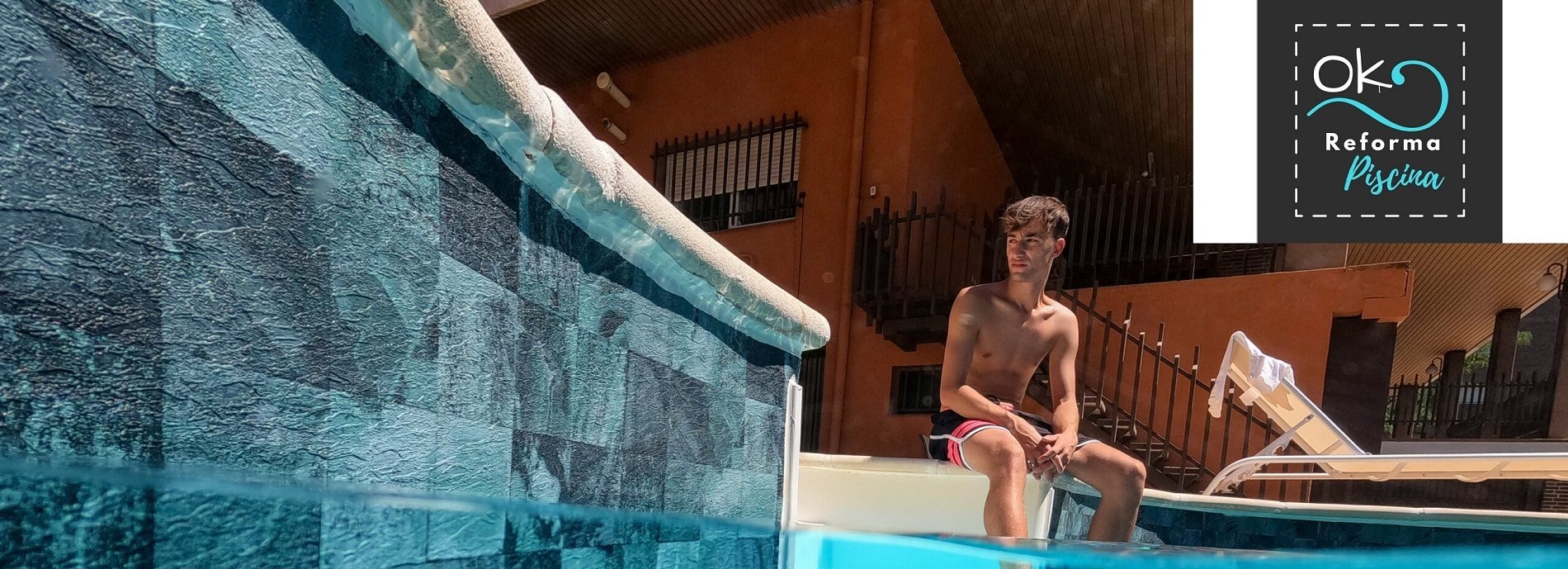
Table of contents of the page
En Ok Pool Reform we present the Main Causes of Water Leaks in Swimming Pools and How to Detect Them.
Principales causas de fugas de agua en piscinas y cómo identificarlas
Sumergirse en una refrescante piscina en un caluroso día de verano es uno de los placeres más gratificantes, pero ¿qué sucede cuando esa agua tan ansiada comienza a desaparecer misteriosamente? En este blog post te mostraremos las principales causas de fugas de agua en piscinas y cómo identificarlas, para que puedas disfrutar al máximo de tu oasis personal sin preocupaciones. ¡Sigue leyendo y descubre cómo mantener tu piscina siempre lista para el chapuzón!
Introducción a las fugas de agua en piscinas
Introducción a las fugas de agua en piscinas
Las piscinas son una excelente forma de refrescarse y divertirse durante el verano, pero también requieren un mantenimiento adecuado para asegurar su correcto funcionamiento. Uno de los problemas más comunes que pueden afectar a una piscina es la fuga de agua. Además de ser una molestia, las fugas pueden causar daños importantes en la estructura y los sistemas de la piscina si no se detectan y reparan a tiempo.
Una fuga de agua en una piscina puede ocurrir por diversas razones, desde factores externos hasta errores durante el proceso de construcción. En esta sección, hablaremos sobre las principales causas de fugas en piscinas y cómo identificarlas.
Causas comunes de fugas en piscinas
Una causa frecuente de fugas en las piscinas es el desgaste natural del material con el que están hechas. Las grietas o roturas en la superficie pueden permitir que el agua se filtre fuera del recipiente. Esto puede deberse al uso continuo e intensivo, así como a cambios bruscos de temperatura.
Otra posible causa es la presión del terreno circundante. Si hay cambios importantes en la presión del suelo debido a lluvias fuertes o deslizamientos, por ejemplo, esto puede ejercer fuerza sobre las paredes y causar fisuras o separaciones entre los materiales.
Además, si la construcción no se realizó correctamente o si hay problemas con el sistema hidráulico, como tuberías rotas o conexiones mal selladas, también puede haber filtraciones.
Cómo identificar una fuga
El primer paso para solucionar una fuga es detectarla. Algunos signos comunes que pueden indicar una fuga de agua en la piscina son:
- Observar un nivel de agua más bajo de lo normal.
- Notar áreas húmedas o manchas en la superficie alrededor de la piscina.
- Escuchar el sonido del agua corriendo incluso cuando el sistema está apagado.
- Ver grietas o separaciones en las paredes o en el piso de la piscina.
Si sospecha que hay una fuga, puede realizar algunas pruebas sencillas para confirmarlo. Por ejemplo, puede colocar un cubo lleno de agua sobre los escalones o dentro de la piscina y marcar su nivel inicial. Después de 24 horas, verifique si hay cambios significativos en el nivel del agua tanto dentro como fuera del cubo. Si es así, es probable que haya una fuga.
Las fugas de agua en las piscinas pueden ser causadas por desgaste natural,
My pool loses water: water leaks in structural pools
When is the time to repair pool cracks?
- The ideal time to repair cracks in the pool is in winter (you can contact us without any obligation).
- Basically, repairing the pool will involve emptying the pool. From another perspective, we also provide you with the page to learn how to empty the pool.
- So, we will also have to contact a technician and invest time.
- Apart from everything, If the pool renovation is carried out in summer, the high temperatures can make some of the renovation processes difficult.
Solution How to fix structural pool leak
Definitive structural pool leak solution: reinforced pool liner
Pool liner: guarantees the tightness of your pool. For all these reasons, we encourage you to consult our page about our reinforced sheet for swimming pools.
Reasons to repair water leaks in a pool with a pool liner
- Firstly, with our pool liner system, we can guarantee the tightness of your pool 100%.
- Furthermore, it is a modern system.
- There are multiple varieties and reinforced liner designs for swimming pools.
- On the other hand, the installation is very quick.
- It adapts perfectly to any type of pool regardless of its shape or the material it is made of.
- Healthy and safe system.
- In this way, you can avoid many risk factors for water leaks in swimming pools.
- And last but not least, we provide you with a 15-year warranty.
- What are you waiting for? Find out without any obligation!
My pool loses water: water leaks due to hydraulic system
In this case, we will treat the lost pool water due to a pool water leak due to the hydraulic system, that is, the PVC pipe network.
On the other hand, it doesn't hurt to consult our page dedicated to knowing how pool filtration works.
What is a water loss through a filtration circuit?
- A loss of water through a filtration circuit is a loss of water due to the filtration circuit (pool water filtering and recirculation system): Number and type of cleaning cycles.
- So, it is a water leak in the pool located between the filtration and pumping circuit, filling and emptying the pool.
- Are most common leaks (they represent around 80%).
- To repair them it is necessary to carry out pressure tests, section by section.
- It is a job that must be carried out by a specialized technician.
Generic problems due to pool water loss through pipes
Normally, Generic problems due to pool water loss through pipes usually occur for the following reasons:
- First most common case, pool water loss at the junction of the skimmer and the pipe.
- Or, lost pool water in the skimmer pipe where it settles with the ground
- Third, the pool loses water due to a crack in the skimmer itself.
- Or, perhaps, pool water lost at the connection of the skimmer pipe with the technical room
Detection of leaks in swimming pools through pipes
Next, we tell you the steps and procedures in a very simple and effective way to detect leaks in pools through pipes (which you can do yourself at home).
Step 1: Detection of leaks in pools through pipes: prepare the pool for the detection of the possible leak
- First step in detecting leaks in pools through pipes: we must have the water level of the pool in the middle of the skimmer (small pool window).
- Secondly, we will stop the pool pump and disconnect the differential.
- We will also close the skimmer, bottom and sweeper ball valves (put the handles perpendicular to the pipes).
- And then we will put the selector valve in the closed position.
STEP 2 Detection of leaks in swimming pools through pipes: water level control
- Find a way to write down and know the water level of the pool, either through, for example: a mark, by hooking a piece of tape or by counting tiles...
- In this way, throughout the necessary days depending on the case of water loss from the pool and always at the same time we will check the water level.
STEP 3 Detection of leaks in swimming pools through pipes: determination of the pool water level
Subtract until the water level remains stable over 24 hours, That is to say, let's not notice that this time the water has dropped, we will have to assess where the level has remained stagnant.
Pool loses water due to skimmer
If the water level is right at the mouth of the skimmer
- First possibility in pool leaks through pipes, the pool water level has stagnated right at the mouth of the skimmer.
- In this case, we will fill the skimmer with a hose and the result in principle will be that it never fills.
- In conclusion, We will have detected that the pool leak is due to the loss of water in the pool from the skimmer pipe being broken..
How to repair pool leak due to skimmer
To repair a pool leak due to a skimmer, we recommend that you contact us without any obligation., because a pool renovation must be carried out and in this case you must have knowledge and experience.
Generic procedure to repair pool leak due to skimmer
- First, make a hole behind the pool skimmer to uncover it.
- Depending on the slab and the mesh that the upper concrete belt has, it will better support the coping stone and the exposed belt.
- Fill the skimmer and start the filtration if you do not see the water leak, sometimes the leak occurs when the pipe increases the pressure due to the suction or delivery.
- If you detect the leak, you must check if the skimmer can be saved or you must replace it and make a new connection.
- For accessories that need to be joined with glue, leave the area clean before gluing.
- Leave the times indicated by the PVC glue you are using.
- Check that it no longer leaks and leave it for about 24 hours to confirm that it is no longer leaking in that area.
- Once confirmed then cover the area.
Video tutorial how to repair leak in pool by skimmer
Below is a video tutorial that will teach you how to repair a leak in a pool due to a skimmer by repairing the pool pipes.
Although, as we have said before, in this case if you have this problem of water leaks in pool skimmer, we recommend that you contact us without any obligation.
Pool loses water due to aspiration
If the water level is right at the suction nozzle of the sweeper:
- On the other hand, if the water level remains in the suction nozzle of the sweeper: plug the nozzle and fill above to check.
- In this case, We will have detected that the pool leak is caused by the loss of water in the pool coming from de the sweeper pipe which will be broken.
Pool leaks water from impellers
If the water level does not match any nozzle
However, if the water level does not match any nozzle, we must proceed to:
- Open only the bottom ball valve and set the selector valve to the filtration position.
- Start the engine.
- If you see the water level go down, the problem The pool leak occurs due to the loss of water in the pool coming from of the delivery pipe.
Pool loses water due to pool light
If the water level is right at the height of the lights
- If the water level is right at the height of the lights, the reading is easy, we have a problem in some joint of the lights.
How to fix pool leak in focus
- Firstly, empty the pool below the spotlights.
- Secondly, check each of the light bulb joints (usually it is a matter of the stuffing box joint that includes the light niches). As you should already know, the spotlight niche is the housing where the spotlight is housed.
- Specifically, you will find 4 gland gaskets (two in the housing where the niche sits and 2 in the niche itself).
- Check and inspect each gasket completely and replace it if there is the slightest suspicion.
- Next, we place the niche inside the casing and fill the pool at the level of the skimmers.
- Then, we will have to wait a few days to authenticate the result.
Video tutorial How to locate a water leak in a pool source
In this video tutorial, you will see how to locate a water leak in a pool source in a professional and specialized way.
In addition, pool leak detection is carried out by testing pool tightness without emptying the water.
And with all this, we present you a solution on how to locate a water leak in a pool source with and without emptying, As always, you can contact us without obligation.
How to know if there are water leaks in swimming pools
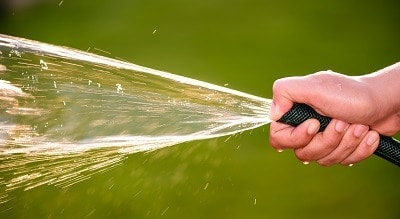
Homemade indicators to know if my pool is losing water due to a leak
1st warning that there may be a pool water leak
- If the water bill has increased.
2nd indicator to check if there is a pool water leak
- Sign in the pool: Mark the water level with a piece of tape or similar and check 24 hours later if the water level has dropped more than 0,5cm (if it has dropped 0,5cm or more, there may be a leak).
3rd home method to know if there is a pool water leak: bucket test

Procedures to know if there is a pool water leak with the bucket test
Cube test: Place a small bucket of water on the pool stairs, matching it to the water level and placing a weight on it to make it stable.
- Fill a 20 liter water bucket with water from the pool.
- Place the bucket on the first or second step of the pool (preferably on the second, without immersion).
- You must then turn off the bomb and then make a mark on the inside of the bucket to mark the internal water level and one on the outside of the bucket to mark the water level of the pool.
- Subsequently, we resume normal operation of the pump (all this ensuring that the automatic filling of the pool is turned off during the test9.
- After 24 hours, check that the water level inside the bucket and outside has decreased proportionally, otherwise it will be synonymous with a leak.
How to detect a pool leak
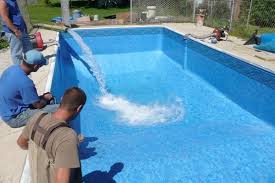
One of the important points when we have doubts about whether our pool is leaking water or not is to check whether or not there really is a water leak.
Types of tests to find a leak in a pool
- Leakage tests with infrared camera.
- Detection with pressure gas.
- Leakage tests with ultrasonic detector.
- Pressure tests with a pump.
- Checking tightness in pipes.
- Conducting tests with a diver through an endoscopic camera.
How to detect water loss in a pool without products
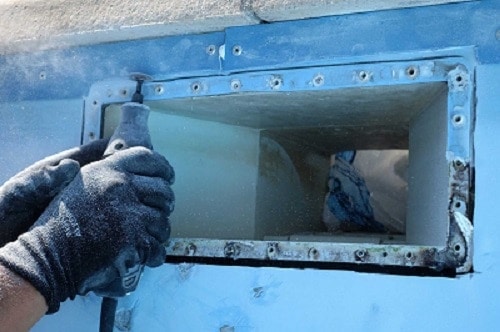
Pool leak detection turning off the filtration system
Possible readings of water loss in the pool by turning off the filtration
- If the water goes down and stops in the skimmer, it means that the leak is either there or in the filtration system.
- On the other hand, we can check if the water descends and stops at the bulb, the leak is surely in the projector.
- Another way would be if the water descends and stops below the bulb, the leak is surely at the bottom of the pool or in the lining of the pool.
- If the pool continues to leak when the pump is running, the leak will be in the recovery system.
Video tutorial how to detect water loss in a pool
Next, the video that we provide you is in case you have previously noticed Lost pool water.
As we said, in this video you will be able to see the steps to detect pool leaks.
In addition, no liquid or tool is used to more quickly detect water leaks in swimming pools.
In any case, as additional information, it is true that there are pool products on the market for this purpose.
How to detect a pool leak with ink
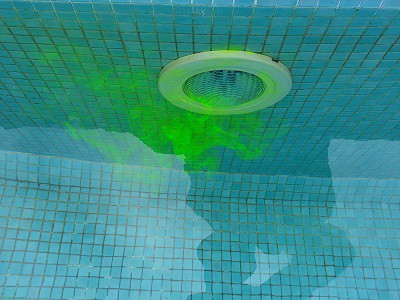
What is the dye test for pool leak detection?
The dye test for leak detection in swimming pools is a product that can be purchased and gives us a guide to know where the leak is, since if there is a hole in the glass or walls of the pool, the dye will mark it.
Thus, it is still a syringe loaded with ink that is not soluble in water that allows possible pool water leaks to be detected using the ink in areas suspected of structural leaks.
In this way, we can rule out or confirm water leaks in the glass or ABS inserts.
Pool leak detection analysis ink
Pool leak detection analysis ink characteristics
[amazon box= «B004IM4LDS » button_text=»Buy» ]
Video tutorial How to detect a pool leak with ink
In this video we show you how to use the special ink for pool leaks, which helped us find a small leak that we had in the tubes of our pool purifier.
How to detect a pool leak

Advanced technology Ok Pool Reform to locate leak in pool
1st method Pool leak detector: Thermal camera
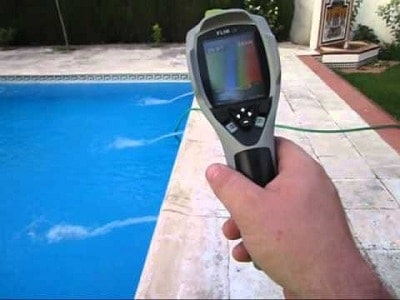
- It is a Reliable and accurate tool for locating water leaks in pool pipes, walls and concrete floor.A totally new system capable of locating filtration points, saving time and money.
- It has become the essential tool capable of generating graphic documentation of water leaks in swimming pools quickly and accurately.
2nd method Pool leak detector: Geophone
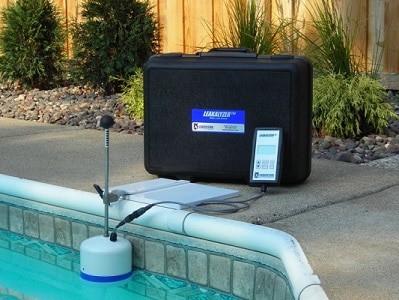
- Electroacoustic water leak detection equipment.
- The geophone pool leak detector is placed on the surface to be investigated and precisely locates the sound waves produced by the damaged pipe.
- Provide certifications once the leak is repaired. Take the measurement and print it on a computer.
- Confirm that a leak exists before beginning testing.
- Confirm that leaks have been fixed upon completion of the repair, saving time and money.
3rd method Pool leak detector: Pipe inspection cameras

- Pipe inspection cameras allow us to enter the pipe to assess the pool leak.
4th method Pool leak detector: detect leaks in pool glasses

- Pool leak detector: leak detector in pool vessels such as fissures, cracks, special fluorescent dyes.
- This method of locating the pool leak is based on a special dye for this function.
- Pool leak dye is very thick and remains suspended in the water.
- And, in the event that there is a leak in a delivery nozzle, in a focus, crack, or in another place, the dye is absorbed immediately to be able to see in a very visual way that there is a pool leak.
How to locate a leak in a removable pool

How to locate and repair a leak in a removable pool
Why do water leaks occur in removable pools?
- The canvas or liner is one of the main pieces of a removable pool.
- This is the part that contains the water, so its care and maintenance so that it is always in good condition will guarantee the proper functioning of the pool and the purifier, in the cases of medium and large-sized pools.
- In any case, in order not to damage the removable pool during its regular cleaning, we suggest you consult the entry about pool cleaning in its specific section on removable pools.
Better to line with pool liner for better leak resistance removable pool
- The material with which the tarp is made is usually PVC plastic, a flexible and highly resistant material at the same time, since during use it is exposed to friction, pressure and tension.
- The thickness of the tarp also determines its resistance with a simple rule, The greater the thickness, the greater the resistance.
How to find a leak in an inflatable pool
Methods to locate a leak in a removable pool
- Dive into the pool and look for the leak by feeling the canvas or with diving goggles
- Look outside the pool for puddles.
- Check the tubes that connect to the purifier
- Let the pool empty itself and see if at any point it stops emptying.
- If your pool has an access ladder, make sure the legs have not damaged the base.
Locate a leak in a removable pool with the bucket test
Procedures to know if there is a pool water leak with the bucket test
- Cube test: Place a small bucket of water on the pool stairs, matching it to the water level and placing a weight on it to make it stable.
- Next, make a mark on the inside of the bucket to mark the internal water level and one on the outside of the bucket to mark the water level of the pool.
- After 24 hours, check that the water level inside the bucket and outside has decreased proportionally, otherwise it will be synonymous with a leak.
How to locate leak holes in removable pool
Causas más comunes de fugas de agua en piscinas
Las fugas de agua en las piscinas pueden ser un problema común y frustrante para los propietarios. No solo puede generar pérdidas de agua, sino también costos adicionales en reparaciones y mantenimiento. Es importante conocer las causas más comunes de estas fugas para poder identificarlas y solucionarlas a tiempo.
La primera causa común de fugas de agua en piscinas es la presión del terreno. Esto ocurre cuando el suelo que rodea la piscina se expande y contrae debido a cambios climáticos, lo que ejerce una presión sobre las paredes de la piscina. Con el tiempo, esta presión puede provocar grietas o roturas en la estructura, lo que permite que el agua se filtre hacia afuera.
Otra causa frecuente son los daños en el revestimiento de la piscina. Si el revestimiento está desgastado o ha sido instalado incorrectamente, puede permitir que el agua salga por pequeñas grietas o agujeros invisibles al ojo humano. Además, si no se realiza un adecuado mantenimiento del pH y cloro del agua, esto puede corroer el revestimiento y causar filtraciones.
También es importante tener en cuenta que cualquier tipo de objeto puntiagudo o afilado dentro de la piscina (como ramas, piedras u otros objetos) pueden perforar fácilmente el revestimiento y crear fugas importantes.
Otra posible razón es una fuga en las tuberías subterráneas. En ocasiones, estas tuberías pueden romperse debido a cambios bruscos en la temperatura o al crecimiento de raíces cercanas. Si hay una fuga subterránea, es posible que note áreas húmedas alrededor de la piscina o un aumento en su factura de agua.
Por último, pero no menos importante, una causa común de fugas en las piscinas son los accesorios desgastados o dañados. Las luces, los skimmers y los chorros pueden deteriorarse con el tiempo y permitir que el agua se escape. Por lo tanto, es importante inspeccionar regularmente estos elementos y reemplazarlos si es necesario.
Si sospecha que su piscina tiene una fuga de agua, es importante tomar medidas rápidamente para evitar mayores daños. Asegúrese de revisar todas estas posibles causas y buscar ayuda profesional si no puede localizar la fuga por su cuenta. Con una detección temprana y reparaciones adecuadas, puede prevenir problemas mayores y disfrutar de su piscina sin preocupaciones durante todo el verano.
Cómo identificar una fuga de agua en tu piscina
Las fugas de agua en una piscina pueden ser un problema común y costoso para los propietarios. Además de afectar la calidad del agua, también puede tener un impacto negativo en la estructura y el funcionamiento de la piscina. Por eso, es importante saber cómo identificar una fuga de agua en tu piscina para poder solucionarla a tiempo.
La primera señal de una posible fuga es cuando el nivel del agua disminuye constantemente sin ninguna razón aparente. Si después de llenar la piscina con agua, notas que el nivel baja más rápido de lo normal, es muy probable que haya una fuga. También puedes notar charcos alrededor o debajo de la piscina, especialmente si no ha llovido recientemente.
Otra forma de identificar una fuga es observando las paredes y el suelo de la piscina. Si hay manchas oscuras o marcas blancas en estos lugares, puede ser indicio de filtraciones detrás del revestimiento o en las tuberías subterráneas. Del mismo modo, si encuentras grietas o roturas en el revestimiento, es importante revisar si hay alguna pérdida de agua.
Presta atención también a cualquier cambio inesperado en el consumo químico del agua. Si tienes que añadir más productos químicos para mantener el equilibrio adecuado del pH y otros niveles, puede ser porque hay una fuga que está diluyendo los químicos.
Un método sencillo pero efectivo para detectar fugas es utilizando un cubo flotante. Llena un cubo con agua hasta el mismo nivel que tu piscina y colócalo sobre uno de los escalones o estantes sumergidos dentro del área de la piscina. Marca el nivel del agua en el interior del cubo y espera entre 24 y 48 horas. Si al volver a revisar, el nivel del agua en la piscina ha bajado más que en el cubo, es señal de una fuga.
Si sospechas que hay una fuga en tu piscina, es importante actuar rápidamente para evitar mayores daños. En primer lugar, cierra todas las válvulas de suministro de agua a la piscina para detener temporalmente la pérdida de agua. Luego, contacta a un profesional especializado para realizar una inspección y reparación adecuada.
Identificar una fuga de agua en tu piscina requiere estar atento a los cambios inesperados en el nivel del agua, manchas o marcas en las paredes y suelo, consumo químico anormal y utilizando métodos sencillos como el cubo flotante. Actuar rápidamente ante cualquier sos
Pasos para reparar una fuga de agua en la piscina
Pasos para reparar una fuga de agua en la piscina
Una vez que hayas identificado la causa de la fuga de agua en tu piscina, es importante actuar rápidamente para evitar mayores daños y costos. Aquí te presentamos los pasos que debes seguir para reparar una fuga de agua en tu piscina.
- Vaciar la piscina: Lo primero que debes hacer es vaciar completamente la piscina hasta que quede únicamente un poco de agua en el fondo. Esto permitirá ver con mayor facilidad dónde se encuentra exactamente la fuga.
- Localizar la fuga: Con un trapo o papel absorbente, seca cuidadosamente todas las zonas alrededor del borde y paredes de tu piscina, prestando especial atención a las juntas y grietas. Si encuentras un área húmeda o notas alguna disminución del nivel del agua, entonces ahí se encuentra probablemente la fuga.
- Marcar la ubicación: Una vez localizada la fuga, marca su ubicación con tiza o algún objeto fácilmente visible para no perderla de vista durante el proceso de reparación.
- Preparar el área: Limpia cuidadosamente el área donde se encuentra la fuga, eliminando cualquier residuo o suciedad que pueda interferir con el proceso de sellado.
- Aplicar masilla epóxica: Utilizando una masilla epóxica específicamente diseñada para reparar fugas en piscinas, aplica una capa generosa sobre el área afectada. Asegúrate de cubrir completamente todas las grietas y fisuras.
- Alisar y dejar secar: Con una espátula o cuchillo liso, alisa la masilla para que quede uniforme y asegúrate de que no haya ninguna burbuja. Deja secar completamente según las instrucciones del producto.
- Llenar la piscina: Una vez seca la masilla, puedes volver a llenar tu piscina con agua hasta su nivel normal.
- Verificar la reparación: Espera 24 horas antes de volver a utilizar tu piscina y verifica si el nivel del agua ha disminuido. Si el problema persiste, es posible que haya más de una fuga o que ésta sea más grande de lo que pensabas, por lo que deberás repetir los pasos anteriores con mayor cuidado.
- Tomar medidas preventivas: Para evitar futuras fugas en tu piscina, es importante tomar medidas preventivas como realizar un mantenimiento regular, revisar periódicamente las juntas y grietas y reparar cualquier daño inmediatamente.
Reparar una fuga de agua en tu piscina puede
Consejos para prevenir futuras fugas de agua en tu piscina
Consejos para prevenir futuras fugas de agua en tu piscina
Las fugas de agua en las piscinas pueden ser un problema molesto y costoso. Además, si no se resuelven a tiempo, pueden causar daños graves en la estructura de la piscina y su entorno. Por ello, es importante tomar medidas preventivas para evitar futuras fugas de agua en tu piscina. A continuación, te brindamos algunos consejos útiles que te ayudarán a mantener tu piscina en perfectas condiciones:
- Realiza inspecciones regulares: La mejor manera de prevenir una fuga es detectarla a tiempo. Por eso, es recomendable realizar inspecciones periódicas en tu piscina para identificar cualquier posible problema antes de que empeore.
- Mantén el nivel adecuado del agua: Un nivel demasiado alto o bajo puede ejercer presión sobre las paredes y el fondo de la piscina, lo que puede provocar grietas y fugas.
- Revisa el sistema de filtración y limpieza: Las obstrucciones o problemas con los sistemas de filtración o limpieza pueden provocar acumulaciones de agua que puedan sobrepasar la capacidad del sistema y ocasionar una fuga.
- Cuida los productos químicos: El uso excesivo o incorrecto de productos químicos puede corroer las tuberías y dañar la estructura general de la piscina, lo que puede generar fugas.
- Vigila los accesorios: Las luces, bombas, válvulas y otros accesorios también pueden ser fuente potencial de fugas si no se encuentran instalados correctamente o están desgastados.
- Evita objetos afilados: No permitas que se introduzcan objetos afilados en la piscina, ya que pueden dañar el revestimiento y provocar fugas.
- Controla la presión del agua: La presión del agua en una piscina puede ser un factor determinante en la aparición de fugas. Si notas que hay una presión excesiva, es importante revisar las tuberías y accesorios para evitar posibles filtraciones.
Siguiendo estos consejos y realizando un buen mantenimiento de tu piscina, podrás prevenir futuras fugas de agua y asegurarte de disfrutarla sin tener que preocuparte por costosas reparaciones. Si sospechas que existe una fuga en tu piscina, no dudes en contactar a un profesional para solucionarlo lo antes posible. Recuerda siempre mantener un buen cuidado de tu piscina para prolongar su vida útil y evitar problemas mayores en el futuro.
Conclusion and final recommendations
Conclusión y recomendaciones finales:
Las fugas de agua en piscinas son un problema común pero muy importante que debe ser abordado de manera oportuna para evitar daños mayores. Al identificar y reparar rápidamente las causas de estas fugas, no solo se ahorra en costes de mantenimiento sino también se asegura una piscina segura y funcionando correctamente.
Para concluir, es esencial realizar un mantenimiento regular de su piscina y estar atento a cualquier signo de fuga de agua. Si nota alguna disminución en el nivel del agua o manchas húmedas alrededor del área de la piscina, es importante tomar medidas inmediatas para evitar problemas mayores.
Además, siempre es recomendable contratar los servicios de profesionales especializados en la reparación y mantenimiento de piscinas para garantizar una solución adecuada y duradera. Estos expertos cuentan con el conocimiento, experiencia y herramientas necesarias para identificar y solucionar cualquier tipo de fuga en su piscina.
Finalmente, recuerde que la prevención es clave para evitar futuras fugas. Inspeccione regularmente su sistema de tuberías y asegúrese de mantener un equilibrio adecuado entre los niveles químicos del agua. Además, evite sobrecargar su piscina con exceso de personas u objetos pesados que puedan dañar el revestimiento o las tuberías.
En conclusión, si sospecha que su piscina tiene una fuga de agua, no espere a que empeore. Actúe rápidamente e implemente estas recomendaciones para identificar la causa exacta y repararla adecuadamente. De esta manera podrá disfrutar de una piscina segura y en óptimas condiciones durante todo el año. ¡Mantenga su piscina en buen estado y disfrute de un verano sin preocupaciones!
